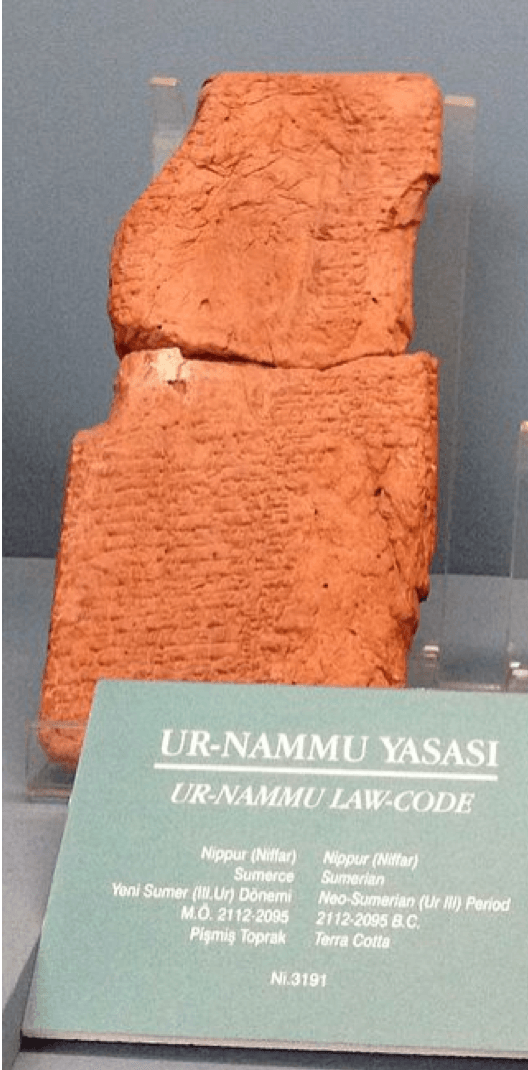by Alasdair Macleod, GoldMoney:

While there have been various theories put forward as to the origin of writing, historians are in general agreement that the first instance of writing can be traced back roughly 4,100 years ago to Sumer.
Map of Ancient Mesopotamia Circa 3000 BC
There, in the ancient cities of Uruk and Jemdet Nasr, nesting in the valleys between the Tigris and Euphrates rivers, the first known civilization thrived. At this epoch, the dominant system of writing was Cuneiform consisting of wedge shaped marks on clay tablets.
TRUTH LIVES on at https://sgtreport.tv/

In 1952, Dr. Samuel Kramer, a noted historian had two fragmented tables excavated at Nippur shipped to him from the Istanbul Archeological Museum. In what was heralded as the most important discovery, Dr. Kramer had found the Code of Ur-Nammu, the oldest written law code (2100 BC) known to man written 300 years before Hammurabi’s law.

The Code of Ur-Nammu — Circa 2100 BC
The Code of Ur-Nammu is arguably the most important piece of factual history we have evidencing human cooperative systems which, at the margin, functioned much like the present. Let us review the prologue of the code as it was written verbatim 4,100 years ago:
“…After An and Enlil had turned over the Kingship of Ur to Nanna, at that time did Ur-Nammu, son born of Ninsun, for his beloved mother who bore him, in accordance with his principles of equity and truth… Then did Ur-Nammu the mighty warrior, king of Ur, king of Sumer and Akkad, by the might of Nanna, lord of the city, and in accordance with the true word of Utu, establish equity in the land; he banished malediction, violence and strife, and set the monthly Temple expenses at 90 gur of barley, 30 sheep, and 30 sila of butter. He fashioned the bronze sila-measure, standardized the one-mina weight, and standardized the stone weight of a shekel of silver in relation to one mina… The orphan was not delivered up to the rich man; the widow was not delivered up to the mighty man; the man of one shekel was not delivered up to the man of one mina.”
To help illustrate the ancient weights and measures today, I offer the following table:
Volume — 1 Sila = 1 Liter — 1 Gur = 300 Liters
Weight — 1 Mina (or Menē) = 567 grams of Gold worth $22,368 today — 60 Shekels of Silver= 1 Mina of Gold (note that even today the ratio of Gold to Silver in the free market is virtually the same at 69)
For the purpose of this essay, I want to focus on what I believe is the single most important deductive conclusion from the Code of Ur-Nammu: The recurrence of Weight as objective and immutable (unchanging over time) measurement. Why is it that the first instance of written law from 4,100 years ago repeatedly refers to the concept of weight as being so crucial to order and fairness? I believe the answer is quite obvious: Because weight is not an abstract human invention to probe reality, it is a feature of reality. Weight is endowed to us by the laws of nature (physics) and is therefore intrinsic to the first order natural properties.
The Foundational Properties of Nature (Basic Physics)
Elements / Matter — Anything you can touch, feel, or breathe is made up of unique building blocks also known as pure elements. Since the time of Sumer, we have been able to classify 92 unique natural elements in our Universe. On our planet, the relative abundance of the elements, and therefore their cost in units of energy and time, is well understood through the lens of geology.
Gravity — A force which pulls matter down.
Weight — An intrinsic phenomena to matter which reflects the intensity or measure of gravity pulling matter down.
Time — The arrow of time (Bergsonian Duration) begins at the inception of our universe and runs until its demise. Cycles of time (Gould) can be compared to the ideas of localized space/time — a measuring system that emanates from a relative gravitational force as seen on our own planet.
Energy and Entropy — Within nature the two most important properties are:
1. Energy, which can be best described as the ability to do work or cause motion. Energy does not originate or dissipate, but is conserved; and
2. Entropy, which acts on any system of energy by urging it toward disorder.
Humans do not cooperate under an economic system within a vacuum. These activities are caused by and are part of nature. Therefore, any inquiry into money, economics, and history requires a deep understanding of our natural world.
Natural Law, Cooperation, and Commodity Money
What is money? and why do we need it? In this section, I will show why any free society is simply a system to organize a division of labor and cooperate for the purpose of achieving an energy surplus (also known as prosperity). Money is simply the signal which most closely mirrors the state of energy surplus or prosperity. The contiguous and growing stock of Money is the sum total of human prosperity, a reservoir of energy at rest which reflects our ability to do work in the future. Like energy itself, money cannot be created or destroyed but merely conserved.
To help convey this concept, I ask you to imagine our world as a computer simulation where the natural properties and forces are immutable features programmed into the source code of the simulation. Now imagine a geographic sphere called Earth which is bound by those features including the endowment of a fixed quantity of matter (“elements”). Next, introduce a seed of multi-cellular organisms (call them “humans”) which, through an innate desire to survive and reproduce, recognize the need to cooperate. Finally, add a dose of “qualities” intrinsic to these organisms— Love, Hate, Fear, Greed, Altruism, Empathy, Courage, Kinship—and run the simulation.
Given enough time, the humans will always figure out the need to organize into a cooperative system (society) that maximizes the usage of energy in order to withstand the forces of entropy. Given the complexity of the system (due in part to the random and infinite variation potentials implicit in human qualities and natural law), a market system will eventually be employed to discover, extract, transport, and exchange various combinations of energy units (goods/services/information) for the purpose of maintaining the rigidity and state of energy surplus with the intent on further growing the energy surplus. It is at this precise moment that a system of accounting (money) between the cooperating humans in the society will arise.



